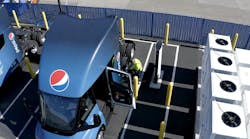SACRAMENTO—Sometimes, a plan just comes together.
When FleetOwner contacted Dave Schaller at the North American Council for Freight Efficiency about joining us for an electric truck event we were planning, the convergence of time and place—to say nothing of theme—was irresistible: Our Commercial Electric Vehicle Infrastructure Conference would be held here just as NACFE kicked off Run on Less – Electric DEPOT, the RMI-affiliated research team’s latest truck technolgy evaluation project.
So representatives of fleets, utilities, and regulatory agencies gathered recently in the capital city of the unofficial capital of EVs to share experiences and expectations about the transition to zero emission vehicles. And the timing couldn’t have been better to hear from vehicle manufacturers, dealers, charging equipment providers, and researchers about where we stand on this journey and, more importantly, where we're hoping to go.
Schaller, NACFE industry engagement director, emphasized the organization's focus on the "real world" in all it does, whether that's making the most of conventional, diesel-powered equipment or making decisions about alternative-fuel vehicles.
See also: NACFE report finds all medium-duty box trucks electrifiable
The new electric depot project follows 2021’s case study of fleets using electric trucks, and the procedures are essentially the same: NACFE finds fleets that are willing to share their data—which can be a challenge, as Schaller noted—then the organization visits the various sites to find out more about the operations, develops a program to gather and assess the data, then measures “real freight, real drivers, real routes” to generate that data.
And, as Schaller was quick to explain, because nearly half of all electric trucks are in California, there’s a good reason the charging depot study is centered on the Golden State.
“For many of those other states, even if they took all the trucks in their whole state and put them on one lot, they don't come out to 15 yet,” he said, referring to NACFE’s minimum EV fleet size for the study. “So here we are.”
On location: Intermodal drayage
On a site-by-site review of the participating fleets, Schaller noted that the Schneider intermodal depot in South El Monte is “probably the best example” of a fast, 100% conversion to electric trucks that NACFE has seen. Additionally, the “slip-seating” operation means the trucks are running 24/7 “for all practical purposes,” other than when charging. By the end of the year, Schneider plans to have 92 Class 8 Freightliner eCascadias at the location.
Indeed, as explained by Jed Proctor, manager of infrastructure strategy for zero emissions vehicles at Daimler Truck North America, Schneider had planned for a 5:1 ratio of trucks to chargers, because charging takes about one-fifth of a shift.
“So the idea is that with 11-hour shifts, the driver comes back and plugs in for a two-hour charging window,” Proctor said. “It’s a last-in, first-out idea. The driver turns in the truck, and dispatch assigns a truck based on which one is the next ready to go out the door.”
And that level of equipment use is critical to evaluating the technology, Schaller noted.
“Nobody knows for sure exactly what the lifetime of a battery is, so right now TCO calculations are pretty darn hard to do with any degree of confidence,” he said. “I'm excited because we're pushing batteries and charging systems hard at this site. It's going to help us understand what the most aggressive implementation looks like.”
The lot features 16 dual-cable chargers at 350 kW each.
“I have to help explain to folks that a big-box store is probably somewhere between half a megawatt to a megawatt, so I've got up to 10 big-box stores all on that one lot,” Schaller said. “We're talking about a four-to-five-year process to get to this standpoint—so this doesn't happen overnight by any means.”
On location: the Pepsi challenge
Run on Less participant Pepsi's high-profile fleet of 21 Tesla Semis is based here in Sacramento.
“We have long haul and city delivery—very different, but with the same truck doing two different applications,” Schaller said.
Specifically, three of the Pepsi electric trucks handle the long-haul runs, typically 250-450 miles per day, while the remaining 18 Teslas are used for local beverage delivery runs that are less than 75 miles per day.
See also: NACFE report affirms hydrogen's major role in long-haul trucking's future
Uniquely, given the variety of Pepsi facilities in the region, trucks rarely run empty as they deliver materials and pick up products, Schaller explained.
“This is really exciting because they run heavy,” he said.
The charging infrastructure in Sacramento consists of four Tesla chargers rated at 750 kW each.
On location: variety
Among the other depots featured in the NACFE Run on Less project (use links for site videos), Schaller noted that:
- Penske’s Ontario site is “the posterchild” for system interoperability, as the fleet features a range of EVs, including eCascadias, International eMVs, and GM BrightDrop ZEVO 600 vans, serviced by Level 2, stationary 150 kW and portable 50 kW chargers and supported by 800 kWh of battery storage.
- Fresno-based OK Produce is building an electric truck fleet because leadership at the family-owned company wants to make “a real environmental statement,” as their business is delivering fresh fruit and produce. And, as Schaller noted, the EV fleet is a good one to watch because “uptime is paramount—when it's fresh, it needs to go out now.” OK also uses three Orange EV terminal tractors. Charging includes 4 MW of solar.
- The UPS facility in Compton is noteworthy because the fleet includes electric last-mile delivery with the Freightliner Custom Chassis Corp. MT50e as well as eCascadias for moves between UPS terminals. The facility, located beneath the package handling level, is “gorgeous” but they have "a headache," Schaller explained: The location falls under a couple of jurisdictions, and the charging infrastructure plan has been delayed. “They've now got one charger sitting outside with power from the building while they're waiting for permission to tear up the yard along the fence to put in the final charging systems,” he said. “So they’re temporarily shuttling trucks in and out of that charger all day long trying to make this work.”
Preliminary results
Since September 11, data has been collected from 22 trucks operating out of 10 fleet depots in the NACFE project.
“The data collection is going well. We used this data along with work we completed prior to the Run to identify the current state of electric trucking and areas where we can expedite improvements to the known challenges,” Mike Roeth, NACFE’s executive director, said. “The electrification of large depots is more realistic than we originally thought, and electric trucks are becoming an option in longer regional haul return-to-base operations.”
See also: Roeth: Bringing trucking's voice to government's EV policymakers
Key data points, initially, according to NACFE:
- Fleets along with their utilities and engineering, procurement, and construction partners are delivering big power — up to 5 MWs — to these depots as well as to charging-as-a-service sites, like WattEV.
- There is a significant amount of electricity needed for these large heavy-duty trucks. It is predicted that Schneider’s South El Monte depot would use 40.2 MWh/day if it were 100% electric, the highest projected daily energy demand we noted.
- The Tesla Semis at PepsiCo’s Sacramento Beverages depot have completed 384 miles on a single charge and 806 miles in a single 24-hour day, enabled by fast 750 kW charging.
- Other Class 8 tractors are demonstrating range at double that of the trucks that took part in Run on Less – Electric in 2021. There is better efficiency, including optimizing regenerative braking and return-to-base charging during single-driver shifts. This has occurred consistently at OK Produce, Penske, Performance Team, PepsiCo and Schneider.
Next up: The nation’s largest truck manufacturer, the largest charging equipment provider, and the largest truck dealership group explain what fleets need to know about commercial EVs.
CEVIC, a pre-conference day ahead of the T&D World Live event, was sponsored by Rush Truck Centers.




